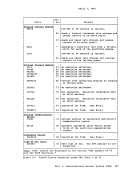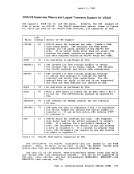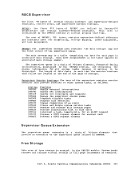Figure 5.
Debug Procedures for UnexpectedResults Unexpected Results in CP --------------------------.., II II • Check that the program is not violating any CP restrictions. Chec* that the f}fogram and {}j)efating system ftmfling on the virtual machine are exactly the same as those
that ran on the real machine.
Use theCP TRACE command to trace CCWs, SIOs, and interrupts.
Look for an error inCCW translation or interrupt reflection . If disk I/O error, use the CP DDR (DASD Dump Restore)
program to print the contents of any disk.
Unexpected results in a virtual machine ----------------------1l! Check that the program executing on the virtual machine is exactly the same as the one that ran on the real machine.
Make sure that operating system restrictions
are notviolated. Use CP TRACE to trace all I/O operations.
Debug Procedures for an ABENDII II Find out why CP abnormally terminated. Examine the PROPSW, INTPR, SVCOPSW, and CPABEND fields in the PSA from the dump. Identify the module that caused the ABEND.
Examine the SAVEAREA, BALRSAVE, and FREESAVE areas of the dump.If I/O operation, examine the real and virtual I/O control blocks. II Determine reason for ABEND from code in ABEND
message DMSABN148T.
Enter debug environment orCP console function mode
to use the commands, to display thePSW, and to examine low storage areas: LASTLMOD and LASTTMOD LASTCMND and PREVCMND LAST EXEC and PREVEXEC and DEVICE Look at the last instruction executed.
Take dump if need be.
Virtual Machine ABEND (other thanCMS) ---------------------; II II Examine dump. if there is one.
UseCP commands to examine registers and
control words.Use CP TR,a,CE '.....j.:;
Debug Procedures forUnexpected Results and an Abend
Part 1.Debugging with Vft/370 17
Debug Procedures for Unexpected
that ran on the real machine.
Use the
Look for an error in
program to print the contents of any disk.
Unexpected results in a virtual machine ----------------------1
Make sure that operating system restrictions
are not
Debug Procedures for an ABEND
Examine the SAVEAREA, BALRSAVE, and FREESAVE areas of the dump.
message DMSABN148T.
Enter debug environment or
to use the commands, to display the
Take dump if need be.
Virtual Machine ABEND (other than
Use
control words.
Debug Procedures for
Part 1.















































































































































































































































































































































































































































